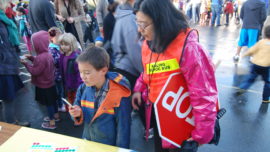
Alta uses effective, efficient, and meaningful metrics that help communities create SRTS programs that are tailored to the needs of their residents. This approach also allows communities to improve program offerings and communicate program success to the public and decision-makers over time.
Successful SRTS programs and projects begin with a data-driven understanding of local challenges combined with community input. Compiling collision data, community demographics, roadway characteristics, and existing conditions enables us to identify problem locations and prioritize improvements where they will have the most benefit, and respond to historic inequities.
This approach not only provides an understanding of what improvements are needed, but also provides metrics to track progress over time. Most recently, Alta has leveraged safety data and comprehensive infrastructure data to understand more clearly the conditions that impact student safety.
Our evaluation of non-infrastructure SRTS programs goes beyond the typical hand tallies and caregiver surveys to collect informative and actionable input from school administrators and SRTS champions. Our caregiver and community surveys use a behavior change model to evaluate mindset shifts, recognizing how long it takes to shift trips. We support a process of continuous improvement by conducting wraparound evaluations that take partners’ and participants’ feedback into account.


